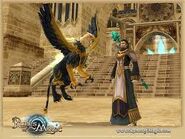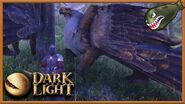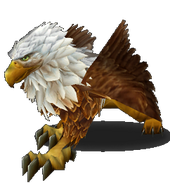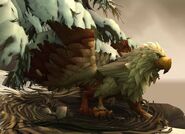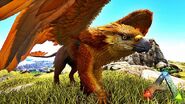m (Reverted edits by 50.176.220.89 (talk | block) to last version by RUBENHC) |
(Editing a gallery) |
||
| (26 intermediate revisions by 13 users not shown) | |||
| Line 1: | Line 1: | ||
| + | {{Film|Name = {{PAGENAME}}|Image = Griffin-2.jpg|Myth basis = [[Greek mythology]]<br/>[[Roman mythology]]}}The '''Griffin''' (Greek gryphos, Persian شیردال shirdal "lion-eagle") (also very often spelled gryphon and, less commonly, gryphen, griffon, griffen, or gryphin) is a legendary creature with the body of a lion and the head and wings of an eagle. Often, griffins are depicted with a pair of prominent ears, traditionally termed "ass's ears". Since the lion was considered the "King of the Beasts" and the eagle the "King of the Air", the griffin was thought to be an especially powerful and majestic creature. Some traditions say that only female griffins have wings. The griffin is generally represented with four legs, wings and a beak, with eagle-like talons in place of a lion's forelegs and equine ears jutting from its skull. Some writers describe the tail as a serpent. See the entry European dragon for a 19th century painting of St George and the dragon, showing a dragon very like a classically-conceived griffin. |
||
| − | {{Creature |
||
| − | |Name=Griffin |
||
| ⚫ | |||
| − | |Parents= |
||
| − | |Consort= |
||
| − | |Children= |
||
| − | |Siblings= |
||
| − | |greekmythologywiki= |
||
| − | |Mythology = [[Greek mythology]], [[Roman mythology]]}} |
||
| − | |||
| − | The'' '''''Griffin''''', ''also spelled '''Griffon''' or '''Gryphon,''' is a legendary creature portrayed with the rear body of a lion, though other animals may be substituted. However, the griffin is always shown with the head of an eagle with erect ears and a feathered torso with the forelegs of an eagle, including its talons. This combination indicates intelligence and strength. As the lion was traditionally considered the king of the beasts and the eagle the king of the birds, the griffin was thought to be an especially powerful and majestic creature. In heraldry, the griffin's amalgamation of lion and eagle gains in courage and boldness and it is always drawn to fierce monsters. It used to denote strength, military courage and leadership. Griffins were thought to be protectors of gold sources, particularly in India. <ref>As to the gold which the griffins dig up, there are rocks which are spotted with drops of gold as with sparks, which this creature can quarry because of the strength of its beak. “For these animals do exist in India” he said, “and are held in veneration as being sacred to the Sun ; and the Indian artists, when they represent the Sun, yoke four of them abreast to draw the images ; and in size and strength they resemble lions, but having this advantage over them that they have wings, they will attack them, and they get the better of elephants and of dragons. But they have no great power of flying, not more than have birds of short flight; for they are not winged as is proper with birds, but the palms of their feet are webbed with red membranes, such that they are able to revolve them, and make a flight and fight in the air; and the tiger alone is beyond their powers of attack, because in swiftness it rivals the winds. |
||
| − | |||
| − | '''Flavius Philostratus, The Life of Apollonius of Tyana, translated by F. C. Conybeare, volume I, book III.XLVIII., 1921, p. 333.'''</ref> |
||
| − | |||
| − | ==History== |
||
| − | |||
| − | Griffins are normally known for guarding treasure. In antiquity it was a symbol of divine power and a guardian of the divine. Most contemporary illustrations give the griffin the forelegs of an eagle, with an eagle's legs and talons. Its eagle's head is conventionally given prominent ears; these are sometimes described as the lion's ears, but are often elongated (more like a horse's), and are sometimes feathered. Infrequently, a griffin is portrayed without wings (or a wingless eagle-headed lion is identified as a griffin); in 15th-century and later heraldry such a beast may be called a male griffin, an alce or a keythong. In heraldry, a griffin always has aquiline forelimbs; the beast with leonine forelimbs is distinguished as the opinicus. |
||
| + | Classical and heraldic griffins are male and female. A so-called "male" griffin, called a keythong in a single 15th century English heraldic manuscript, is an anomaly that belongs strictly to a late phase of English heraldry: see below. |
||
| − | ==Medieval Lore== |
||
| − | |||
| − | Griffins mated for life and never sought a new mate if their partner was to die. According to Stephen Friar's ''New Dictionary of Heraldry,'' "a griffin's claw was believed to possess medicinal properties and that it's feathers could restore sight to the blind." By the 12th century, the appearance of the griffin had been settled upon and remains relatively unchanged in modern lore. "All of its bodily members are like lion's but it's wings and mask are like an eagle's. It was not yet clear if it's forelimbs are like a lions or an eagle's or sometimes it is possible that they had the limbs of baby pigs. |
||
| − | |||
| − | ==In Media== |
||
| + | == Appearance and nature of griffins == |
||
| ⚫ | |||
| + | The griffin is usually depicted as a large creature. Its eagle head and neck are covered in fluffy white feathers, and its forelegs are eagle talons. It has a lion body with brown fur and a tufted furry tail. It also possesses feathered eagle wings and horse-like ears. |
||
| + | Tales of griffins and the Arimaspi of distant Scythia near the cave of Boreas, the North Wind (Geskleithron) were elaborated in the lost archaic poem of Aristeas of Proconnesus, Arimaspea, and eagerly reported by Herodotus and in Pliny's Natural History. The griffin was said to build a nest, like an eagle. Instead of eggs, it lays agates. The animal was supposed to watch over gold mines and hidden treasures, and to be the enemy of the horse. The incredibly rare offspring of griffin and horse would be called hippogriff. Griffin was consecrated to the Sun; and ancient painters represented the chariot of the Sun as drawn by griffins. The griffin was a common feature of "animal style" Scythian gold; it was said to inhabit the Scythia steppes that reached from the modern Ukraine to central Asia; there gold and precious stones were abundant; and when strangers approached to gather the stones, the creatures would leap on them and tear them to pieces. The Scythians used giant petrified bones found in this area as proof of the existence of griffins and to keep outsiders away from the gold and precious stones. It has recently been suggested that these "griffin bones" were actually dinosaur fossils, which are common in this part of the world. |
||
| + | ''Heraldic guardian griffin at Kasteel de Haar, Netherlands'' |
||
| − | *A griffin was featured in ''Scooby-Doo! Abracadabra Doo'' with its own mythical backstory. |
||
| + | Adrienne Mayor, a classical folklorist, has made tentative connections, in Fossil Hunters: Paleontology in Greek and Roman Times, between the rich fossil beds around the Mediterranean and across the steppes to the Gobi Desert and the myths of griffins, centaurs and archaic giants originating in the classical world. Mayor draws upon striking similarities that exist between the Protoceratops skulls of the steppes leading to the Gobi Desert, and the legends of the gold-hoarding griffin told by nomadic Scythians of the region; among the artistic evidence, the 6th century Greek vase on the book's cover is incontrovertible. The size of that fossil skull may be the source of the claim that a griffin is eight times the size of a lion. |
||
| ⚫ | |||
| − | * Gilda (''My Little Pony Friendship is Magic'') |
||
| − | * Griffins (''American Dragon: Jake Long'') |
||
| + | In Persian mythology, in particular during Achaemenid Persians Griffins under name Homa was used widely as statues and symbols in palaces. Homa has also an special place in Persian literature as a guardian of light. |
||
| ⚫ | |||
| − | |||
| − | *In Tamora Pierce's ''Protector of the Small'' Quartet, no lies could be spoken in their presence. In addition, wearing a band of griffin's feathers revealed hidden things and dispelled illusions. |
||
| − | *In the film adaptation of ''The Chronicles of Narnia: The Lion, the Witch and the Wardrobe'', the griffins could speak the language of humans. They did not appear in the book. |
||
| − | *A gryphon appears in ''The Adventures of Alice in Wonderland'' by Lewis Carroll |
||
| + | A modernist, Egyptianized guardian griffin, Washington D.C.A 9th century Irish writer by the name of Stephen Scotus asserted that griffins were highly monogamous. Not only did they mate for life, but if one partner died, the other would continue throughout the rest of its life alone, never to search out for a new mate. The griffin was thus made an emblem of the Church's views on remarriage. |
||
| ⚫ | |||
| − | |||
| − | *Griffins appear in the ''Warcraft'' universe as flying mounts for the Wildhammer and Bronzebeard Dwarf Clans. |
||
| + | The egg-laying habits of the female were first clearly described by St. Hildegard of Bingen, a German nun author of the 12th century. She outlined how the expectant mother would search out a cave with a very narrow entrance but plenty of room inside, sheltered from the elements. Here she would lay her 3 eggs (about the size of Ostrich eggs), and stand guard over them. |
||
| − | *Griffins appear in The Witcher universe with common mythical lore, in which the Witcher, Geralt of Rivia, has to combat on multiple occasions. |
||
| + | In architectural decoration the griffin is usually represented as a four-footed beast with wings and the head of a leopard or tiger with horns, or with the head and beak of an eagle. The griffin is the symbol of the Philadelphia Museum of Art and you can see bronze castings of them perched on each corner of the museum's roof, protecting its collection. |
||
| − | == Habitat == |
||
| + | |||
| − | Their habitats are the skies and in the high mountains where they guard the treasures of immortality. |
||
| + | A griffin (spelled "gryphon") is featured in Lewis Carroll's Alice in Wonderland in which the Queen of Hearts' orders the gryphon to take Alice to see the Mock Turtle and hear its story. The original illustrations by Sir John Tenniel depict the gryphon in an unusually naturalistic style (pictured to the left). |
||
| + | |||
| + | Some large species of Old World vultures are called gryphons, including the griffon vulture (Gyps fulvus), as are some breeds of dog (griffons). |
||
| + | |||
| + | == Heraldic griffins == |
||
| + | A heraldic griffin (or gryphon) has the hind parts (including legs and tail) of a lion, the upper parts (including feathered neck, wings, claws, and head with beak) of an eagle and also ears. It is the ears which distinguish the griffin's head from an eagle's head in heraldry, which is important because, as well as the full griffin, the griffin's head is also often found in heraldry and would otherwise be identical to the head of the eagle. |
||
| + | |||
| + | According to John de Bado Aureo (late fourteenth century) “A griffin borne in arms signifies that the first to bear it was a strong pugnacious man in whom were found two distinct natures and qualities, those of the eagle and the lion”. This is clearly fanciful, but since the lion and the eagle were both important charges in heraldry, it is perhaps not surprising that their hybrid, the griffin, was also a frequent choice. The symbolism of the lion-eagle combination was also the subject of a quotation attributed to Chassaneus by Alexander Nisbet in his System of Heraldry (1722; p 343 of Vol I of the 1816 edn): "Gryphus significat sapientiam jungendam fortitudini, sed sapientiam debere praeire, fortitudinem sequi.". This translates as: “The griffin represents wisdom joined to fortitude, but wisdom should lead, and fortitude follow". |
||
| + | |||
| + | ''Modern illustration of a heraldic griffin - coat of arms of the Griffiths family'' |
||
| + | |||
| + | Heraldic griffins are usually shown rearing up, facing left, and standing on one hind leg with the other leg and the claws raised: this posture is described in the Norman-French language of heraldry as "segreant", a word uniquely applied to griffins, and which is the exact equivalent of the description of lions and other creatures in heraldry as "rampant". |
||
| + | |||
| + | A heraldic griffin was included as one of the ten Queen's Beasts sculpted for the coronation of Queen Elizabeth II in 1953 (following the model of the King’s Beasts at Hampton Court) and this is now on display at Kew Gardens. |
||
| + | |||
| + | The City of London adopted what are usually described as griffins as supporters for its coat of arms, and it marks its boundaries with statues of a single "griffin" carrying the City coat of arms at each road leading into the City of London. However, the City of London griffins are, in fact, heraldic dragons, with scaly bodies and wings, no feathers, and no eagle's beak. |
||
| + | |||
| + | == The "Keythong" == |
||
| + | The heraldic beast called a "keythong" much enjoyed among members of the Society for Creative Anachronism is claimed to appear in a single English manuscript of the reign of Edward IV, a heraldic solipsism. J.R. Planche's Pursuivant of Arms (London 1859) notes, under the badge of the Earl of Ormonde (first creation) as recorded in a College of Arms manuscript under Edward IV, the single contemporary reference: "A pair of keythongs." Planche's footnote: "The word is certainly so written, and I have never seen it elsewhere. |
||
| + | |||
| + | The figure resembles the Male Griffin, which has no wings, but rays or spikes of gold proceeding from several parts of his body, and sometimes with two long straight horns. Vade Parker's Glossary, under Griffin." (Society of Creative Anachronism website). At the end of the 20th century the "keythong" began to be taken up enthusiastically among amateurs of heraldry. |
||
| + | |||
| ⚫ | |||
| + | The Crossroads series by Nick O'Donohoe, including The Magic and the Healing, Under the Healing Sign, and Healing of Crossroads. Griffins play a significant role in this series about veterinary students called upon to help mythological creatures. Harry Potter's house (i.e. grouping of pupils) at Hogwarts is called Gryffindor. The Gryffindor house is named after the Gryffindor founder Godric Gryffindor. "Gryffindor" comes from the French "Gryffon d'or" or "golden griffin," but, oddly, its coat of arms is a lion and not a griffin. The Griffin and the Minor Canon by Frank R Stockton, illustrated by Maurice Sendak (1968) The Mage Wars Trilogy by Mercedes Lackey and Larry Dixen. A gryphon known as Skandranon is one of the lead characters. Titles are The Black Gryphon, The White Gryphon and The Silver Gryphon. |
||
| + | |||
| + | Spelling variants Griffin has been spelled various ways: gryphon, griffen, griffon, griffoun, griffun, griffyn, grifo, grifon, grifyn, grefyne, griphin, griphon, gryffen, gryffin, gryffon, gryfon, gryphen, and gryphin. |
||
==Related Creatures== |
==Related Creatures== |
||
| Line 52: | Line 52: | ||
*[[Sphinx]] |
*[[Sphinx]] |
||
*[[Opinicus]] |
*[[Opinicus]] |
||
| + | ==Gallery== |
||
| − | |||
| + | |||
| ⚫ | |||
| + | === Mythology and Folklore === |
||
| + | |||
| ⚫ | |||
| + | <gallery> |
||
| + | ON-prerelease-Gryphon.jpg|A Griffin or Gryphon in Elder Scrolls Online. |
||
| + | Griffin01.png |
||
| + | download - 2019-09-05T114615.165.jpg |
||
| + | maxresdefault - 2019-09-05T114635.203.jpg |
||
| + | images (94).jpg |
||
| + | images (95).jpg |
||
| + | Gryphon (2).png |
||
| + | 800px-Alpine_Gryphon.jpg |
||
| + | 799px-Aerie_Gryphon.jpg |
||
| + | 200px-Wintergarde_Gryphon.jpg |
||
| + | 200px-Dawnfeather_Gryphon.jpg |
||
| + | 200px-Enraged_Gryphon.jpg |
||
| + | 200px-Fordragon_Armored_Gryphon.jpg |
||
| + | 200px-Onslaught_Gryphon_Rider.jpg |
||
| + | 200px-Gilnean_Gryphon.jpg |
||
| + | 200px-Razorbeak_Gryphon.jpg |
||
| + | 200px-Razorbeak_Skylord.jpg |
||
| + | 200px-Soaring_Razorbeak.jpg |
||
| + | 200px-Untamed_Gryphon.jpg |
||
| + | Wild_Gryphon.jpg |
||
| + | 643x0w.jpg |
||
| + | Griffin-TheWitcher.jpg |
||
| + | hqdefault (96).jpg |
||
| + | banner_winback-campaign_blog.jpg |
||
| + | CwxiibbUoAAmO0_.jpg |
||
| + | Snow_Gryphon_(Running) (1).jpg |
||
| + | griff-600x338.jpg |
||
| + | Griffin_sol.png |
||
| + | </gallery> |
||
| + | |||
| ⚫ | |||
| + | <gallery> |
||
| + | b734f0301bb2ead3bf3c0230124a0c1a-1.jpg|Griffin or Gryphon from The Chronicles of Narnia. |
||
| + | topps-warcraft-movie-cards-3.png |
||
| + | griffin_1973_01.jpg |
||
| + | griffin_2008_01.jpg |
||
| + | </gallery> |
||
| + | |||
| ⚫ | |||
| + | <gallery> |
||
| + | Griffin_(Quest_for_Camelot)_profile.png|Griffin (Quest for Camelot) |
||
| + | four_legged_hawk_by_tacimur_d5x9cx.jpg |
||
| + | Griffin-AdventuresOfTheGummiBears.jpg |
||
| ⚫ | |||
| + | griffondefeated07.jpg |
||
| + | 1-Griffon_01-.jpg |
||
| + | The_Storm_Griffin.png |
||
| + | 1-050-Griffon_001.jpg |
||
| + | 1-014A-GriffinisHunted.jpg |
||
| + | Full_view_of_Griffonstone_S6E19.png |
||
| + | stymphalian .PNG |
||
| + | download - 2019-09-10T131035.404.jpg |
||
| + | </gallery> |
||
| + | |||
| + | === Comics === |
||
| + | <gallery> |
||
| + | Griffon.png |
||
| + | </gallery> |
||
| + | |||
| ⚫ | |||
<references/> |
<references/> |
||
| − | [[Category:Mythical |
+ | [[Category:Mythical creatures]] |
[[Category:C. S. Lewis Mythology]] |
[[Category:C. S. Lewis Mythology]] |
||
| ⚫ | |||
| ⚫ | |||
| ⚫ | |||
[[Category:Medieval Mythology]] |
[[Category:Medieval Mythology]] |
||
| ⚫ | |||
| ⚫ | |||
[[Category:Antagonists]] |
[[Category:Antagonists]] |
||
[[Category:Flying things]] |
[[Category:Flying things]] |
||
[[Category:Feline]] |
[[Category:Feline]] |
||
| ⚫ | |||
[[Category:Hybrid]] |
[[Category:Hybrid]] |
||
| + | [[Category:Creatures]] |
||
| ⚫ | |||
| ⚫ | |||
Revision as of 18:10, 10 September 2019
The Griffin (Greek gryphos, Persian شیردال shirdal "lion-eagle") (also very often spelled gryphon and, less commonly, gryphen, griffon, griffen, or gryphin) is a legendary creature with the body of a lion and the head and wings of an eagle. Often, griffins are depicted with a pair of prominent ears, traditionally termed "ass's ears". Since the lion was considered the "King of the Beasts" and the eagle the "King of the Air", the griffin was thought to be an especially powerful and majestic creature. Some traditions say that only female griffins have wings. The griffin is generally represented with four legs, wings and a beak, with eagle-like talons in place of a lion's forelegs and equine ears jutting from its skull. Some writers describe the tail as a serpent. See the entry European dragon for a 19th century painting of St George and the dragon, showing a dragon very like a classically-conceived griffin.
Classical and heraldic griffins are male and female. A so-called "male" griffin, called a keythong in a single 15th century English heraldic manuscript, is an anomaly that belongs strictly to a late phase of English heraldry: see below.
Appearance and nature of griffins
The griffin is usually depicted as a large creature. Its eagle head and neck are covered in fluffy white feathers, and its forelegs are eagle talons. It has a lion body with brown fur and a tufted furry tail. It also possesses feathered eagle wings and horse-like ears. Tales of griffins and the Arimaspi of distant Scythia near the cave of Boreas, the North Wind (Geskleithron) were elaborated in the lost archaic poem of Aristeas of Proconnesus, Arimaspea, and eagerly reported by Herodotus and in Pliny's Natural History. The griffin was said to build a nest, like an eagle. Instead of eggs, it lays agates. The animal was supposed to watch over gold mines and hidden treasures, and to be the enemy of the horse. The incredibly rare offspring of griffin and horse would be called hippogriff. Griffin was consecrated to the Sun; and ancient painters represented the chariot of the Sun as drawn by griffins. The griffin was a common feature of "animal style" Scythian gold; it was said to inhabit the Scythia steppes that reached from the modern Ukraine to central Asia; there gold and precious stones were abundant; and when strangers approached to gather the stones, the creatures would leap on them and tear them to pieces. The Scythians used giant petrified bones found in this area as proof of the existence of griffins and to keep outsiders away from the gold and precious stones. It has recently been suggested that these "griffin bones" were actually dinosaur fossils, which are common in this part of the world.
Heraldic guardian griffin at Kasteel de Haar, Netherlands
Adrienne Mayor, a classical folklorist, has made tentative connections, in Fossil Hunters: Paleontology in Greek and Roman Times, between the rich fossil beds around the Mediterranean and across the steppes to the Gobi Desert and the myths of griffins, centaurs and archaic giants originating in the classical world. Mayor draws upon striking similarities that exist between the Protoceratops skulls of the steppes leading to the Gobi Desert, and the legends of the gold-hoarding griffin told by nomadic Scythians of the region; among the artistic evidence, the 6th century Greek vase on the book's cover is incontrovertible. The size of that fossil skull may be the source of the claim that a griffin is eight times the size of a lion.
In Persian mythology, in particular during Achaemenid Persians Griffins under name Homa was used widely as statues and symbols in palaces. Homa has also an special place in Persian literature as a guardian of light.
A modernist, Egyptianized guardian griffin, Washington D.C.A 9th century Irish writer by the name of Stephen Scotus asserted that griffins were highly monogamous. Not only did they mate for life, but if one partner died, the other would continue throughout the rest of its life alone, never to search out for a new mate. The griffin was thus made an emblem of the Church's views on remarriage.
The egg-laying habits of the female were first clearly described by St. Hildegard of Bingen, a German nun author of the 12th century. She outlined how the expectant mother would search out a cave with a very narrow entrance but plenty of room inside, sheltered from the elements. Here she would lay her 3 eggs (about the size of Ostrich eggs), and stand guard over them.
In architectural decoration the griffin is usually represented as a four-footed beast with wings and the head of a leopard or tiger with horns, or with the head and beak of an eagle. The griffin is the symbol of the Philadelphia Museum of Art and you can see bronze castings of them perched on each corner of the museum's roof, protecting its collection.
A griffin (spelled "gryphon") is featured in Lewis Carroll's Alice in Wonderland in which the Queen of Hearts' orders the gryphon to take Alice to see the Mock Turtle and hear its story. The original illustrations by Sir John Tenniel depict the gryphon in an unusually naturalistic style (pictured to the left).
Some large species of Old World vultures are called gryphons, including the griffon vulture (Gyps fulvus), as are some breeds of dog (griffons).
Heraldic griffins
A heraldic griffin (or gryphon) has the hind parts (including legs and tail) of a lion, the upper parts (including feathered neck, wings, claws, and head with beak) of an eagle and also ears. It is the ears which distinguish the griffin's head from an eagle's head in heraldry, which is important because, as well as the full griffin, the griffin's head is also often found in heraldry and would otherwise be identical to the head of the eagle.
According to John de Bado Aureo (late fourteenth century) “A griffin borne in arms signifies that the first to bear it was a strong pugnacious man in whom were found two distinct natures and qualities, those of the eagle and the lion”. This is clearly fanciful, but since the lion and the eagle were both important charges in heraldry, it is perhaps not surprising that their hybrid, the griffin, was also a frequent choice. The symbolism of the lion-eagle combination was also the subject of a quotation attributed to Chassaneus by Alexander Nisbet in his System of Heraldry (1722; p 343 of Vol I of the 1816 edn): "Gryphus significat sapientiam jungendam fortitudini, sed sapientiam debere praeire, fortitudinem sequi.". This translates as: “The griffin represents wisdom joined to fortitude, but wisdom should lead, and fortitude follow".
Modern illustration of a heraldic griffin - coat of arms of the Griffiths family
Heraldic griffins are usually shown rearing up, facing left, and standing on one hind leg with the other leg and the claws raised: this posture is described in the Norman-French language of heraldry as "segreant", a word uniquely applied to griffins, and which is the exact equivalent of the description of lions and other creatures in heraldry as "rampant".
A heraldic griffin was included as one of the ten Queen's Beasts sculpted for the coronation of Queen Elizabeth II in 1953 (following the model of the King’s Beasts at Hampton Court) and this is now on display at Kew Gardens.
The City of London adopted what are usually described as griffins as supporters for its coat of arms, and it marks its boundaries with statues of a single "griffin" carrying the City coat of arms at each road leading into the City of London. However, the City of London griffins are, in fact, heraldic dragons, with scaly bodies and wings, no feathers, and no eagle's beak.
The "Keythong"
The heraldic beast called a "keythong" much enjoyed among members of the Society for Creative Anachronism is claimed to appear in a single English manuscript of the reign of Edward IV, a heraldic solipsism. J.R. Planche's Pursuivant of Arms (London 1859) notes, under the badge of the Earl of Ormonde (first creation) as recorded in a College of Arms manuscript under Edward IV, the single contemporary reference: "A pair of keythongs." Planche's footnote: "The word is certainly so written, and I have never seen it elsewhere.
The figure resembles the Male Griffin, which has no wings, but rays or spikes of gold proceeding from several parts of his body, and sometimes with two long straight horns. Vade Parker's Glossary, under Griffin." (Society of Creative Anachronism website). At the end of the 20th century the "keythong" began to be taken up enthusiastically among amateurs of heraldry.
Griffins in Literature
The Crossroads series by Nick O'Donohoe, including The Magic and the Healing, Under the Healing Sign, and Healing of Crossroads. Griffins play a significant role in this series about veterinary students called upon to help mythological creatures. Harry Potter's house (i.e. grouping of pupils) at Hogwarts is called Gryffindor. The Gryffindor house is named after the Gryffindor founder Godric Gryffindor. "Gryffindor" comes from the French "Gryffon d'or" or "golden griffin," but, oddly, its coat of arms is a lion and not a griffin. The Griffin and the Minor Canon by Frank R Stockton, illustrated by Maurice Sendak (1968) The Mage Wars Trilogy by Mercedes Lackey and Larry Dixen. A gryphon known as Skandranon is one of the lead characters. Titles are The Black Gryphon, The White Gryphon and The Silver Gryphon.
Spelling variants Griffin has been spelled various ways: gryphon, griffen, griffon, griffoun, griffun, griffyn, grifo, grifon, grifyn, grefyne, griphin, griphon, gryffen, gryffin, gryffon, gryfon, gryphen, and gryphin.
Related Creatures
Fellow Lion/other hybrids.



